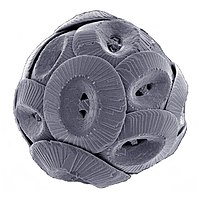
Photo from wikipedia
Despite lower hardness, stiffness, and resistance to harsh environments, heavy metallic parts and soft polymer-based composites are often preferred to ceramics because they offer higher resilience. By contrast, highly mineralized… Click to show full abstract
Despite lower hardness, stiffness, and resistance to harsh environments, heavy metallic parts and soft polymer-based composites are often preferred to ceramics because they offer higher resilience. By contrast, highly mineralized biomaterials combine these properties through hierarchical and heterogeneous architecture. Reproducing these internal designs into synthetic highly mineralized materials would therefore widen their range of application. To this aim, external fields have been used to control the orientation and position of microparticles and build complex architectures. This approach is compatible with most manufacturing processes and provides large flexibility in design. Here, I present an overview of these processes and describe how they can augment the properties of the materials produced. Theoretical and experimental descriptions are detailed to determine the strengths and limitations of each technique. With this knowledge, potential areas of improvement and future research directions will lead to the creation of highly mineralized materials with unprecedented functionalities.
Journal Title: Journal of Materials Research
Year Published: 2019
Link to full text (if available)
Share on Social Media: Sign Up to like & get
recommendations!